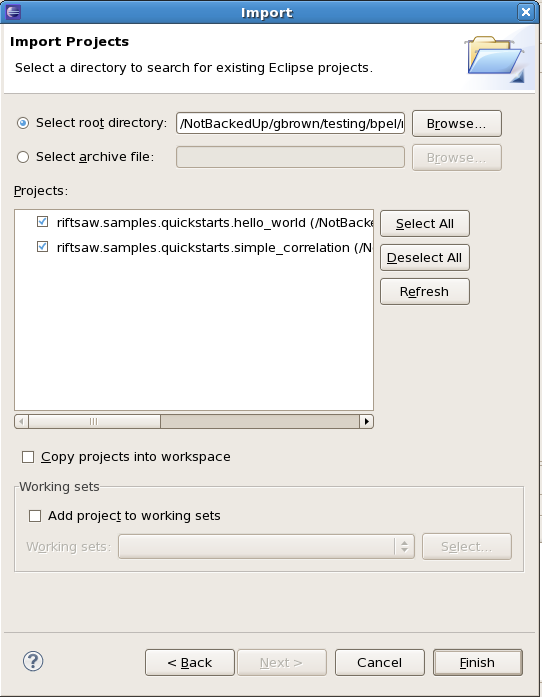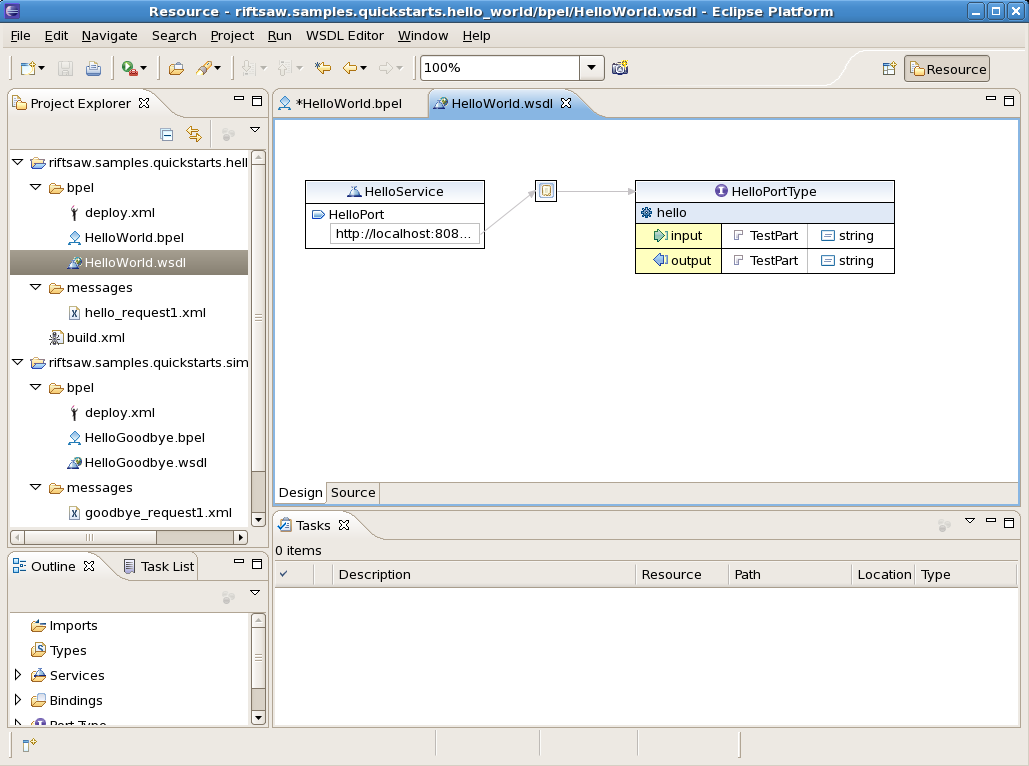This chapter provides a getting started guide to the examples. Further information on the individual examples can be found in the samples folder.
If using the Eclipse BPEL editor, bundled with
JBoss Tools, then you can import
the quickstart samples as Eclipse BPEL projects, by selecting the import
menu item on the left navigation panel in Eclipse, and choosing the
General->Existing Projects into Workspace option. Then
select the individual sample you wish to import, or alternatively select the
${RiftSaw}/samples/quickstart folder to select multiple
(or all) samples for import. Please see the RiftSaw User Guide for information
on how to deploy the BPEL samples to the server.
Before deploying any of the examples, you need to start the JBossAS server and ensure that RiftSaw has been installed. This can be achieved by testing whether the BPEL Console (as discussed in the User Guide) is available.
The BPEL example we are going to try out is the simple
'hello world' example. This is located in the
${RiftSaw}/samples/quickstarts/hello_world
folder.
The first step is to deploy the example to the running JBossAS server. This is achieved using the following command:
ant deploy
When the ant script indicates that it has completed successfully, the next step is to invoke the BPEL process we have just deployed.
This can be achieved using either the supplied ant script,
ant sendhello
Or by using any SOAP client, such as SOAPUI (available from http://www.soapui.org/).
The WSDL definition is located in the bpel
folder, and can be used to initialise the SOAPUI client. The
service location is:
http://localhost:8080/Quickstart_hello_worldWS.
An example message can be found in the messages
subfolder.

When the message is submitted to the BPEL process, the response received is:

If you then wish to modify the example and deploy a new version, you will need
to either update the 'version' property within the build.xml,
or specify the version when performing the command, e.g.
ant -Dversion=2 deploy
and similarly when undeploying,
ant -Dversion=2 undeploy
Note
When modifying a previously deployed BPEL deployment, it will be necessary to either undeploy the previous version, or increment the version number. If you attempt to deploy a BPEL deployment unit with the same name as an already deployed unit, then the server will generate an exception.
Warning
Currently the version must be specified as a single integer value. Non-numeric values, such as versions expressed in a major.minor.incremental (maven style), will result in an exception when deployed to the server.
This quickstart example demonstrates how an ESB service can directly invoke a BPEL process running inside RiftSaw, as long as RiftSaw and the ESB are co-located in the same JVM, and the invoked BPEL process is deployed to the RiftSaw instance running co-located with the JBossESB.
The example that we are going to use is located in the
${RiftSaw}/samples/esb/bpel_helloworld folder.
Also note that the quickstart described in the preceding section,
located in the ${RiftSaw}/samples/quickstarts/hello_world
must still be deployed. If this example is not deployed, then please follow
the instructions in the previous section to deploy the example.
The next step is to deploy the ESB service that will invoke this "hello world"
BPEL process. This is achieved by performing the following command in the
${RiftSaw}/samples/esb/bpel_helloworld
folder:
ant deploy
Once the ESB service has been successfully deployed, then run the following command:
ant runtest
This command will send the text "Hello World via ESB to BPEL" to the ESB service, which will invoke the BPEL process, which in turn will append "World" to the text and echo it back until it is received by the client application.
For more information on the ESB to RiftSaw integration, please see the User Guide.
The quickstart examples, provided with the RiftSaw distribution, can be imported into an Eclipse environment as BPEL2.0 projects. This enables the BPEL and WSDL to be viewed using Eclipse based editors. Please see the JBoss Tools project for access to appropriate versions of these tools that work with the RiftSaw runtime engine.
Select the 'Import...' menu item, associated with the popup menu on the background of the left panal (Navigator or Package depending on perspective being viewed).
When the import dialog appears, select the General->ExistingProject from Workspace option and press the 'Next' button.

Ensuring that the 'Select root directory' radio button is selected, press the 'Browse' button and navigate to the
${RiftSaw}/samplesfolder, then press 'Ok'.
All of the Eclipse projects contained within the
samplesdirectory structure will be listed. Press the 'Finish' button to import them all.
Once imported, the Eclipse navigator will list the sample projects:

Once imported, the BPEL and WSDL artifacts can be viewed by double-clicking the appropriate files.

